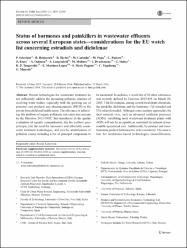| dc.contributor.author | Schröder, Peter | |
| dc.contributor.author | Helmreich, Brigitte | |
| dc.contributor.author | Skrbic, Bilijana | |
| dc.contributor.author | Carballa, Marta | |
| dc.contributor.author | Papa, Matteo | |
| dc.contributor.author | Pastore, Carlo | |
| dc.contributor.author | Mascolo, Giuseppe | |
| dc.contributor.author | Pagano Meriç, Süreyya | |
| dc.date.accessioned | 2022-05-11T14:17:19Z | |
| dc.date.available | 2022-05-11T14:17:19Z | |
| dc.date.issued | 2016 | |
| dc.identifier.issn | 0944-1344 | |
| dc.identifier.issn | 1614-7499 | |
| dc.identifier.uri | https://doi.org/10.1007/s11356-016-6503-x | |
| dc.identifier.uri | https://hdl.handle.net/20.500.11776/6314 | |
| dc.description.abstract | Present technologies for wastewater treatment do not sufficiently address the increasing pollution situation of receiving water bodies, especially with the growing use of personal care products and pharmaceuticals (PPCP) in the private household and health sector. The relevance of addressing this problem of organic pollutants was taken into account by the Directive 2013/39/EU that introduced (i) the quality evaluation of aquatic compartments, (ii) the polluter pays principle, (iii) the need for innovative and affordable wastewater treatment technologies, and (iv) the identification of pollution causes including a list of principal compounds to be monitored. In addition, a watch list of 10 other substances was recently defined by Decision 2015/495 on March 20, 2015. This list contains, among several recalcitrant chemicals, the painkiller diclofenac and the hormones 17 beta-estradiol and 17 alpha-ethinylestradiol. Although some modern approaches for their removal exist, such as advanced oxidation processes (AOPs), retrofitting most wastewater treatment plants with AOPs will not be acceptable as consistent investment at reasonable operational cost. Additionally, by-product and transformation product formation has to be considered. The same is true for membrane-based technologies (nanofiltration, reversed osmosis) despite of the incredible progress that has been made during recent years, because these systems lead to higher operation costs (mainly due to higher energy consumption) so that the majority of communities will not easily accept them. Advanced technologies in wastewater treatment like membrane bioreactors (MBR) that integrate biological degradation of organic matter with membrane filtration have proven a more complete elimination of emerging pollutants in a rather cost- and labor-intensive technology. Still, most of the presently applied methods are incapable of removing critical compounds completely. In this opinion paper, the state of the art of European WWTPs is reflected, and capacities of single methods are described. Furthermore, the need for analytical standards, risk assessment, and economic planning is stressed. The survey results in the conclusion that combinations of different conventional and advanced technologies including biological and plant-based strategies seem to be most promising to solve the burning problem of polluting our environment with hazardous emerging xenobiotics. | en_US |
| dc.description.sponsorship | COSTEuropean Cooperation in Science and Technology (COST) | en_US |
| dc.description.sponsorship | This opinion paper has been compiled by members of COST Action ESSEM1202 (www.water2020.eu) on the basis of fruitful discussions in a task force focusing on emerging contaminants. The authors acknowledge the financial support by COST (www.cost.eu) for their meetings. | en_US |
| dc.language.iso | eng | en_US |
| dc.publisher | Springer Heidelberg | en_US |
| dc.identifier.doi | 10.1007/s11356-016-6503-x | |
| dc.rights | info:eu-repo/semantics/openAccess | en_US |
| dc.subject | Diclofenac | en_US |
| dc.subject | Ethinylestradiol | en_US |
| dc.subject | Emerging pollutants | en_US |
| dc.subject | Effluent quality | en_US |
| dc.subject | EU watch list | en_US |
| dc.subject | Pollutant removal | en_US |
| dc.subject | Advanced technologies | en_US |
| dc.subject | Personal Care Products | en_US |
| dc.subject | Endocrine Disrupting Compounds | en_US |
| dc.subject | Advanced Oxidation Processes | en_US |
| dc.subject | Sewage-Treatment Plants | en_US |
| dc.subject | Linear Ion-Trap | en_US |
| dc.subject | Environmental Risk-Assessment | en_US |
| dc.subject | Accurate Mass Measurements | en_US |
| dc.subject | Powdered Activated Carbon | en_US |
| dc.subject | Neutral Photo-Fenton | en_US |
| dc.subject | Pharmaceutical Residues | en_US |
| dc.title | Status of hormones and painkillers in wastewater effluents across several European states-considerations for the EU watch list concerning estradiols and diclofenac | en_US |
| dc.type | review | en_US |
| dc.relation.ispartof | Environmental Science and Pollution Research | en_US |
| dc.department | Fakülteler, Çorlu Mühendislik Fakültesi, Çevre Mühendisliği Bölümü | en_US |
| dc.authorid | 0000-0002-7409-0235 | |
| dc.authorid | 0000-0003-4340-6118 | |
| dc.authorid | 0000-0002-0569-0982 | |
| dc.authorid | 0000-0003-4872-3411 | |
| dc.authorid | 0000-0003-4872-3411 | |
| dc.authorid | 0000-0002-8615-8989 | |
| dc.authorid | 0000-0001-9981-0983 | |
| dc.identifier.volume | 23 | en_US |
| dc.identifier.issue | 13 | en_US |
| dc.identifier.startpage | 12835 | en_US |
| dc.identifier.endpage | 12866 | en_US |
| dc.institutionauthor | Pagano Meriç, Süreyya | |
| dc.relation.publicationcategory | Diğer | en_US |
| dc.authorscopusid | 7005968780 | |
| dc.authorscopusid | 6603109791 | |
| dc.authorscopusid | 7003271130 | |
| dc.authorscopusid | 9242899200 | |
| dc.authorscopusid | 36454063600 | |
| dc.authorscopusid | 7006635643 | |
| dc.authorscopusid | 6602551155 | |
| dc.authorwosid | CARBALLA, MARTA/P-7454-2015 | |
| dc.authorwosid | Martinez-Lopez, Emma/H-1685-2015 | |
| dc.authorwosid | Martínez-López, Emma/AAB-3097-2019 | |
| dc.authorwosid | Tsagarakis, Konstantinos P./N-1403-2017 | |
| dc.authorwosid | Schroeder, Peter/AAP-7988-2020 | |
| dc.authorwosid | Papa, Matteo/AAH-3731-2020 | |
| dc.authorwosid | Papa, Matteo/E-5731-2012 | |
| dc.identifier.wos | WOS:000378817300026 | en_US |
| dc.identifier.scopus | 2-s2.0-84962273575 | en_US |
| dc.identifier.pmid | 27023823 | en_US |



















